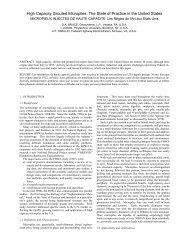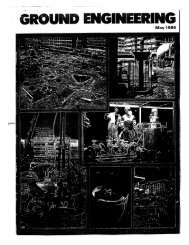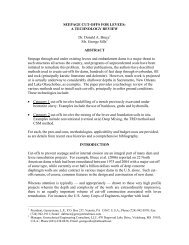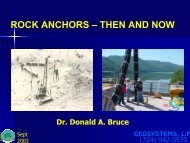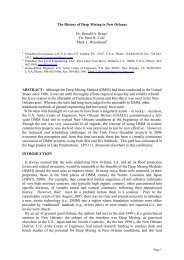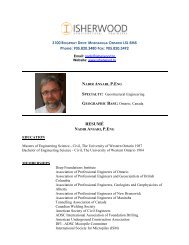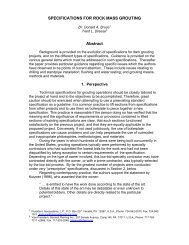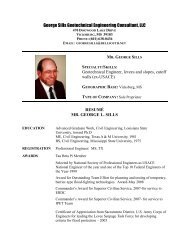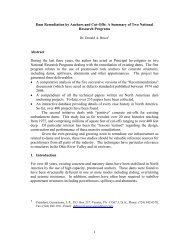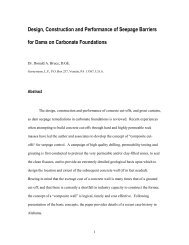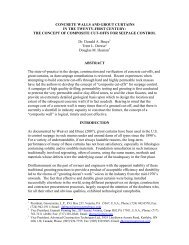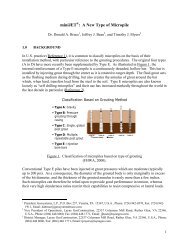high capacity and fully removable soil anchors - Geosystems, L.P.
high capacity and fully removable soil anchors - Geosystems, L.P.
high capacity and fully removable soil anchors - Geosystems, L.P.
You also want an ePaper? Increase the reach of your titles
YUMPU automatically turns print PDFs into web optimized ePapers that Google loves.
THE BENEFITS OF ENHANCED ANCHOR<br />
TECHNOLOGY<br />
Benefits of Increased Anchor Capacity<br />
The cost of the installation of an anchor is<br />
generally controlled by:<br />
• Time to set up <strong>and</strong> start drilling<br />
• Drilling time through structure or<br />
materials (wall or fill)<br />
• Drilling time for free length of anchor<br />
• Drilling time for fixed length of anchor<br />
• Tendon material costs<br />
• Grouting time <strong>and</strong> materials costs<br />
• Anchor head material<br />
• Stressing time<br />
The SBMA achieves time <strong>and</strong> cost savings by<br />
providing two times the working load of a<br />
normal anchor, thereby halving the number of<br />
anchor. The net savings are not necessarily<br />
halved, but are on the order of 20%. The<br />
drilling <strong>and</strong> installation time is practically<br />
halved while the total tendon <strong>and</strong> anchor head<br />
costs are of the same order as the original<br />
scheme. Stressing time is increased for a<br />
multiple anchor, although the total time is<br />
undoubtedly less than that required to stress<br />
twice the number of conventional <strong>anchors</strong>.<br />
Cost savings may be shared generally<br />
between the anchor installer, the contractor,<br />
<strong>and</strong> the owner.<br />
Fewer <strong>anchors</strong> also provide time savings due<br />
to a reduction in the number of wall<br />
penetration points (less ducts, reinforcement<br />
penetration or holes to be burned) <strong>and</strong> a<br />
reduction in the risk of operations in locations<br />
where <strong>high</strong> ground water level is present.<br />
Fewer rows of <strong>anchors</strong> reduce disruption<br />
during excavation <strong>and</strong> reduce the number of<br />
waling levels. Perhaps the most significant<br />
benefit is the reduction of the overall<br />
construction period, which may be as much as<br />
40% <strong>and</strong> is generally to the advantage of the<br />
Contractor <strong>and</strong> Owner.<br />
Benefits of Removable Anchor Systems<br />
Row(s) of temporary anchor tendons left in<br />
place can inhibit future construction especially<br />
in urban areas. Conventional piling rigs,<br />
diaphragm walling rigs, or boring rigs can<br />
easily penetrate existing grout <strong>and</strong> plastic<br />
components (saddle from <strong>removable</strong><br />
systems), although ab<strong>and</strong>oned steel<br />
components may prove impenetrable. In<br />
many of the world’s larger cities, the use of<br />
temporary <strong>anchors</strong> for <strong>soil</strong>/wall retention is<br />
only tolerated if removal of the steel tendons<br />
can be guaranteed (e.g., Edinburgh, London,<br />
Hong Kong, Singapore, <strong>and</strong> Berlin).<br />
CASE HISTORIES<br />
Although many projects have achieved these<br />
time <strong>and</strong> cost savings since the introduction of<br />
the system in the early 1990s, three<br />
international projects provide suitable<br />
illustration.<br />
Excavation for Central Station, Hong Kong<br />
At Central Station in Hong Kong, a 20-m deep<br />
excavation 120 m long <strong>and</strong> 75 m wide was<br />
retained using up to 5 levels of 200-tonne<br />
working <strong>capacity</strong> multiple <strong>anchors</strong> (probably<br />
the <strong>high</strong>est <strong>capacity</strong> <strong>soil</strong> <strong>anchors</strong> ever<br />
installed). The general contractor would not<br />
have considered an anchor solution if such<br />
working capacities could not be achieved<br />
(Barley et al., 1999). Closely-spaced horizontal<br />
struts were used as retention in the adjacent<br />
section (Photograph 3). Structures constructed<br />
in the open-space excavation were completed<br />
3 months earlier than those in the adjacent<br />
strutted section.<br />
Deep Excavation, Singapore<br />
In Singapore, a vertical bored pile wall is<br />
currently being retained by 150-tonne working<br />
load <strong>anchors</strong> (Barley <strong>and</strong> Kiat, 2002)<br />
(Photograph 4). The use of these <strong>high</strong><br />
<strong>capacity</strong> <strong>anchors</strong> allowed the contractor to<br />
reduce the number of <strong>anchors</strong> in half with a<br />
considerable overall time saving. The<br />
performance of the <strong>anchors</strong> <strong>and</strong> the integrity of<br />
the corrosion protection system were<br />
demonstrated in test <strong>anchors</strong> <strong>and</strong> gun barrel<br />
tests prior to production.<br />
Slope Stabilization, Natchez, MS<br />
In Natchez, MS, slope stabilization <strong>and</strong><br />
retention projects have been undertaken to<br />
arrest slope erosion along the Mississippi<br />
River. Stabilization of the slope has been<br />
difficult due to the need to achieve adequate<br />
bond stresses in the ultra-sensitive finegrained<br />
loess <strong>soil</strong> at the retention level. A trial<br />
multiple anchor was installed, <strong>and</strong> an anchor<br />
system of adequate <strong>capacity</strong> for permanent<br />
<strong>soil</strong> retention was provided (Photograph 5)<br />
(Fairweather, 1997).




